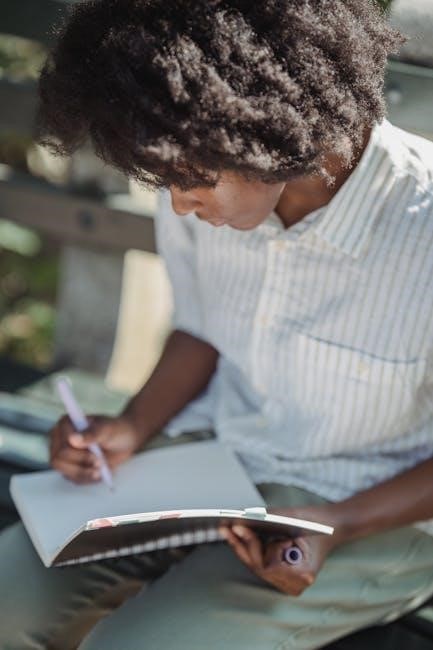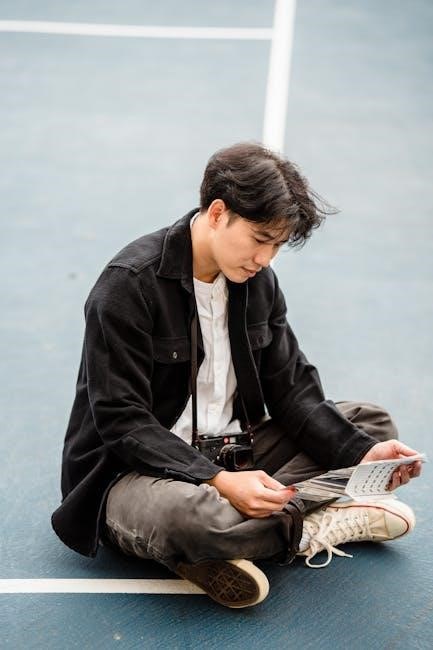Student self-reflection questions are a powerful tool in education, helping students analyze their learning experiences and thoughts. They encourage intentional thinking and accountability, fostering growth and understanding.
Understanding the Importance of Self-Reflection for Students
Self-reflection is a vital skill for students, enabling them to gain insights into their learning processes, strengths, and areas for improvement. By engaging in self-reflection, students develop a deeper understanding of their academic and personal growth. It encourages them to take ownership of their learning, identify patterns in their performance, and make informed decisions to enhance their outcomes. Self-reflection fosters critical thinking, resilience, and emotional intelligence, all of which are essential for lifelong learning. Regular reflection helps students recognize their progress, celebrate achievements, and address challenges constructively. This practice not only improves academic performance but also prepares students to navigate real-world situations with confidence and self-awareness.
Overview of Self-Reflection Questions and Their Purpose
Self-reflection questions are designed to prompt students to think deeply about their learning experiences, goals, and progress. These questions help students identify what they know, what they need to improve, and how they can achieve their objectives. They are categorized into types such as backward-looking, inward-looking, and forward-looking, each serving a unique purpose. Backward-looking questions focus on past experiences, inward-looking on personal feelings and beliefs, and forward-looking on future actions. Educators use these questions to guide students in developing self-awareness, critical thinking, and problem-solving skills. By aligning reflection questions with learning objectives, educators ensure that students connect their experiences with academic and personal growth, fostering a more intentional and meaningful learning process.

Benefits of Student Self-Reflection
Self-reflection empowers students to enhance learning, critical thinking, and personal growth. It fosters accountability, resilience, and emotional intelligence, leading to improved academic performance and intellectual development.
Enhancing Self-Awareness and Personal Growth
Self-reflection questions empower students to gain insight into their strengths, weaknesses, and values, fostering a deeper understanding of themselves. By exploring their thoughts and experiences, students develop self-awareness, which is crucial for personal growth. This process helps them identify areas for improvement, celebrate achievements, and set meaningful goals. Reflective practices encourage students to evaluate their beliefs and behaviors, leading to increased emotional intelligence and maturity. Over time, self-reflection cultivates a mindset of continuous learning and self-improvement, enabling students to navigate challenges with confidence and resilience. This personal growth translates into all areas of life, making self-reflection a vital skill for long-term success.
Improving Academic Performance and Critical Thinking
Self-reflection questions play a significant role in enhancing academic performance by helping students analyze their learning experiences and identify areas for improvement. By evaluating their understanding and engagement with course material, students can address knowledge gaps and develop a clearer grasp of complex concepts. Reflective practices also foster critical thinking, as students are encouraged to assess the effectiveness of their study strategies and problem-solving approaches. This process enables them to refine their methods, leading to better academic outcomes. Additionally, reflecting on assignments and feedback promotes deeper understanding and the ability to apply knowledge in new contexts, further enhancing intellectual and academic growth.
Developing Emotional Intelligence and Resilience
Self-reflection questions empower students to explore their emotions, beliefs, and values, fostering emotional intelligence. By examining their reactions to challenges, students gain insights into their emotional responses and develop self-awareness. This process helps them recognize patterns in their behavior and thought processes, enabling better emotional regulation. Reflective practices also cultivate resilience by encouraging students to identify strengths and areas for growth. Through questioning, students learn to reframe setbacks as opportunities for learning, building confidence and adaptability. Enhanced emotional intelligence and resilience equip students to navigate academic and personal challenges more effectively, promoting holistic development and lifelong well-being.

Models of Self-Reflection
Models of self-reflection offer structured frameworks for students to systematically analyze their experiences and growth. These frameworks encourage deep thinking and intentional analysis, enhancing learning outcomes effectively.
The What? So What? Now What? Model
The What? So What? Now What? Model is a simple yet effective framework for self-reflection. Developed by Driscoll (1994), it guides students through three key questions to analyze their experiences. The first question, What?, encourages students to describe what happened. The second, So What?, helps them explore the significance and emotions tied to the experience. Finally, Now What? prompts them to think about future actions or improvements. This model is accessible for all educational levels and fosters deeper understanding, emotional awareness, and goal-setting skills. It is widely used in education to promote meaningful reflection and personal growth, making it a cornerstone of self-reflection practices.
Gibbs’ Reflective Cycle
Gibbs’ Reflective Cycle is a structured model for self-reflection, consisting of five stages: description, feelings, evaluation, analysis, and action. It encourages students to systematically examine their experiences. The cycle begins with Self-reflection questions are categorized into backward-looking, inward-looking, and forward-looking types. These questions guide students in assessing past experiences, analyzing personal feelings, and planning future actions for growth and improvement. Backward-looking questions focus on past experiences, helping students assess what they knew, how they learned, and what they achieved. These questions encourage reflection on prior knowledge and processes, such as “What did you know about this topic before?” or “How did you approach this task?” They help students evaluate their learning journey, identify strengths, and recognize areas for improvement. By examining past experiences, students gain insights into their progress and develop a clearer understanding of their academic growth. These questions are essential for fostering accountability and continuous improvement, making them a cornerstone of effective self-reflection practices in education. Inward-looking questions guide students to examine their personal thoughts, feelings, and beliefs about their learning experiences. These questions help students connect with their internal processes, such as “What did you find most challenging?” or “What are you proud of in your work?” They encourage students to explore their emotions, motivations, and values, fostering a deeper understanding of themselves as learners. Inward-looking questions also help students identify their strengths and weaknesses, enabling them to set meaningful goals for personal growth. By focusing on internal reflections, these questions promote self-awareness, emotional intelligence, and a stronger sense of agency over their educational journey. This type of questioning is vital for developing introspective thinking and lifelong learning skills. Forward-looking questions inspire students to think about future actions, goals, and improvements. These questions encourage planning and aspiration, such as “What steps can you take to improve next time?” or “How will you apply what you’ve learned?” They help students set clear objectives and develop strategies for achieving them. Forward-looking questions also promote problem-solving and proactive thinking, enabling students to anticipate challenges and prepare for them. By focusing on the future, these questions motivate students to take ownership of their learning, build resilience, and strive for continuous progress. This type of questioning is essential for fostering a growth mindset and preparing students for lifelong success. Divergent questions encourage students to explore multiple perspectives, generating a wide range of ideas and solutions. These open-ended questions, such as “What are different ways to approach this problem?” or “How might various factors influence the outcome?” foster creativity and critical thinking. In contrast, convergent questions are more structured, guiding students toward specific answers or strategies, like “What is the best way to solve this?” or “How can you apply this concept to a real-life scenario?” Both types of questions are valuable: divergent questions promote brainstorming, while convergent questions help refine ideas and focus on practical applications. Together, they balance exploration and precision in self-reflection. Effective self-reflection questions are clear, specific, and aligned with learning objectives. They prompt students to analyze experiences, set goals, and use rubrics for self-assessment and growth. Useful reflection questions are clear, specific, and open-ended, encouraging deep thinking and analysis. They align with learning objectives, fostering meaningful connections to the material. These questions should be relevant, prompting students to explore their experiences, challenges, and growth. They often begin with “what,” “how,” or “why,” inviting honest and thoughtful responses; Effective questions also promote critical thinking and self-awareness, helping students identify strengths and areas for improvement. They encourage students to consider multiple perspectives and articulate their learning process. Well-crafted questions avoid leading or biased language, ensuring neutrality and inclusivity. By guiding students to reflect purposefully, these questions enhance learning outcomes and personal development; They are essential tools for fostering intentional reflection and academic success. Tailoring reflection questions to suit various learning levels ensures accessibility and engagement for all students. For younger or novice learners, questions should be simple and guided, focusing on basic reflections like “What did you learn?” or “How did you feel?” As students progress, questions can become more complex, incorporating critical thinking, such as “How does this connect to what we studied earlier?” Open-ended questions like “What would you do differently next time?” encourage deeper analysis. Advanced learners benefit from abstract inquiries like “How does this apply to real life?” Aligning questions with students’ cognitive abilities ensures they are both challenging and achievable, fostering growth and understanding. This approach supports differentiated instruction and caters to diverse learning needs. Rubrics play a crucial role in guiding self-reflection by clarifying expectations and criteria for learning. They help students assess their own performance, identify strengths, and pinpoint areas for improvement, fostering accountability and targeted growth. Rubrics serve as a guide for students to evaluate their own work effectively. By outlining clear criteria and expectations, rubrics help students identify their strengths and areas needing improvement. This structured approach enables learners to align their self-assessment with specific learning objectives, fostering a deeper understanding of their progress. Rubrics also promote accountability, as students can use them to set realistic goals and track their development over time. When integrated with reflection questions, rubrics create a comprehensive framework for meaningful self-assessment, empowering students to take ownership of their learning journey and strive for continuous improvement. This alignment enhances the effectiveness of self-reflection, making it a powerful tool for academic and personal growth. Aligning reflection questions with learning objectives ensures that students focus on meaningful aspects of their learning. Educators can design questions that directly tie to specific goals, helping students connect their experiences with intended outcomes. For example, questions like, “How did this activity help you understand the concept of [topic]?” guide students to reflect on their progress toward mastery. This alignment clarifies expectations and encourages students to think critically about their achievements. By linking reflection to objectives, educators help students identify gaps in understanding and develop strategies to address them. This intentional approach enhances the relevance of self-reflection, making it a tool for both assessment and growth. Regular use of such questions fosters a deeper understanding of learning objectives and their application. Students often face challenges in self-reflection, such as difficulty articulating thoughts or lacking honesty. Educators can overcome these by providing structured prompts and fostering a supportive environment, ensuring meaningful engagement and growth. Students often encounter barriers when engaging in self-reflection, such as difficulty articulating their thoughts or hesitancy to be honest about their experiences; Some may struggle with vague thinking or lack the necessary vocabulary to express their insights. Additionally, fear of judgment or embarrassment can prevent students from openly sharing their reflections. Time constraints and unclear expectations about the reflection process can also hinder meaningful engagement. Without proper guidance, students may find it challenging to identify meaningful learning moments or connect their experiences to broader goals. These barriers highlight the need for educators to provide structured prompts and a supportive environment to facilitate authentic and impactful reflection. To foster honest and meaningful reflection, educators should create a safe and supportive environment where students feel comfortable sharing their thoughts. Providing clear guidelines and examples helps students understand the purpose of reflection. Encouraging the use of specific questioning techniques, such as backward-looking questions, can guide students in identifying key learning moments. Additionally, incorporating rubrics to assess reflective responses can clarify expectations and promote deeper thinking. Offering constructive feedback and allowing time for self-assessment also empowers students to take ownership of their learning. By modeling reflective practices themselves, educators can inspire students to embrace reflection as a valuable tool for growth and understanding. Reflection questions vary by type, including backward-looking, inward-looking, and forward-looking inquiries. Examples include: “What did you learn?” “How did you feel?” and “What would you do differently?” Math: “How did you approach solving the complex problem? What strategies worked best, and what would you do differently next time?” Science: “What observations surprised you during the experiment? How did they align with your hypothesis?” Literature: “What themes did the author emphasize? How do these relate to your own experiences or broader societal issues?” History: “What historical event impacted you most? Why is it significant, and how does it influence your understanding of the present?” Art: “What inspired your creative choices in this project? How do you think others might interpret your work?” These questions encourage students to reflect critically on their learning and connect academic content to personal growth and understanding. Reflection questions can be applied in various real-life situations to help students connect learning to practical experiences. For example, after a group project, students might reflect on their role and contributions, fostering teamwork awareness. In resolving conflicts, questions like “What could I have done differently?” encourage emotional growth; When setting personal goals, reflection questions help students identify strengths and areas for improvement. These scenarios enable students to apply reflective thinking to everyday challenges, enhancing problem-solving and decision-making skills. By integrating reflection into real-life contexts, students develop a deeper understanding of themselves and their place in the world, preparing them for future endeavors. This practice bridges academic learning with real-world application, fostering holistic development. Self-reflection practices can be incorporated into daily or weekly routines, with questions tailored to specific intervals. Regular reflection, such as at the start of a new year, fosters consistent growth and self-awareness. Students should engage in self-reflection regularly, with practices tailored to their learning needs and developmental levels. Daily or weekly reflection sessions can foster consistent growth, while less frequent, deeper reflections may be more effective for older students. The frequency should align with learning objectives, ensuring students have time to process experiences and apply insights. For younger students, brief daily check-ins can cultivate self-awareness, while older students may benefit from weekly or bi-weekly reflections. Educators should guide the process, balancing structure with flexibility to accommodate individual pacing and developmental stages. Regular reflection helps students develop a habit of intentional thinking, enhancing their academic and personal growth over time. Integrating reflection into daily or weekly routines helps students develop consistent self-awareness and intentional learning habits. Short, structured check-ins, such as end-of-day reflection journals or quick verbal sharing, can be effective for younger students. For older students, weekly reflection sessions or digital submissions encourage deeper thinking. Educators can incorporate reflection prompts into homework assignments or class starters, making it a seamless part of the learning process. Flexibility is key, as routines should adapt to students’ needs and developmental stages. Regular reflection practices, even in small doses, foster a culture of continuous improvement and personal growth, helping students connect their experiences to broader learning goals. Educators play a vital role in fostering reflection by creating opportunities for students to engage in self-assessment and critical thinking. They guide students in using tools like rubrics to support meaningful self-reflection, helping them grow academically and personally. Educators play a crucial role in guiding students through the reflection process by creating a supportive and structured environment. They can introduce models like the “What? So What? Now What?” framework to provide a clear structure for reflection. By using backward-looking questions, educators help students analyze past experiences, while inward-looking questions encourage personal insights. Rubrics can be aligned with reflection questions to offer clear criteria for self-assessment. Consistency is key, with weekly reflections being a balanced approach to avoid overwhelming students. Providing constructive feedback on reflections is essential, focusing on specific aspects to encourage growth without discouragement. Incorporating real-life scenarios can make reflections more meaningful, helping students connect their learning to practical applications. By combining these strategies, educators can effectively foster a culture of reflection that enhances student learning and personal development. Providing feedback on reflective responses is crucial for fostering student growth and understanding. To ensure effectiveness, feedback should be specific, aligning with rubrics and reflection questions to meet clear criteria. Timing is key—offer feedback promptly while experiences are fresh, yet avoid overwhelming students with excessive information. Balance positive reinforcement with constructive criticism to encourage improvement without discouragement. Use both written and verbal formats, allowing for deeper engagement and clarification. Maintain consistency across educators through aligned strategies and guidelines. Encourage students to reflect on feedback, incorporating actionable steps for future learning. Be mindful of cultural sensitivities and individual differences to ensure equitable feedback. Training educators in feedback techniques and utilizing peer feedback can enhance quality. Document feedback to track progress and involve students in setting goals, promoting ownership and motivation in their learning journey. Real-world examples and case studies illustrate the practical application of self-reflection questions in education. For instance, a middle school classroom used backward-looking questions to assess project outcomes, revealing improved collaboration skills. A university implemented Gibbs’ Reflective Cycle, enhancing critical thinking in nursing students. In STEM, divergent questions helped students explore creative solutions to environmental challenges. These examples demonstrate how tailored reflection strategies can address diverse learning needs. Case studies highlight the importance of aligning questions with learning objectives, as seen in a history class where inward-looking questions deepened students’ understanding of historical events. Such applications provide actionable insights for educators to refine their teaching methods and support student development effectively.
Types of Self-Reflection Questions
Backward-Looking Questions
Inward-Looking Questions
Forward-Looking Questions
Divergent and Convergent Questions

Creating Effective Self-Reflection Questions
Key Characteristics of Useful Reflection Questions
How to Tailor Questions for Different Learning Levels

The Role of Rubrics in Self-Reflection
Using Rubrics to Guide Self-Assessment
Aligning Reflection Questions with Learning Objectives

Addressing Challenges in Student Self-Reflection
Common Barriers to Effective Reflection
Strategies to Encourage Honest and Meaningful Reflection

Providing Examples of Reflection Questions
Sample Questions for Different Academic Subjects
Real-Life Scenarios for Applying Reflection Questions
The Frequency of Self-Reflection Practices
How Often Should Students Engage in Self-Reflection?
Integrating Reflection into Daily or Weekly Routines

The Role of Educators in Promoting Reflection
Guiding Students Through the Reflection Process
Providing Feedback on Reflective Responses

Examples and Case Studies
